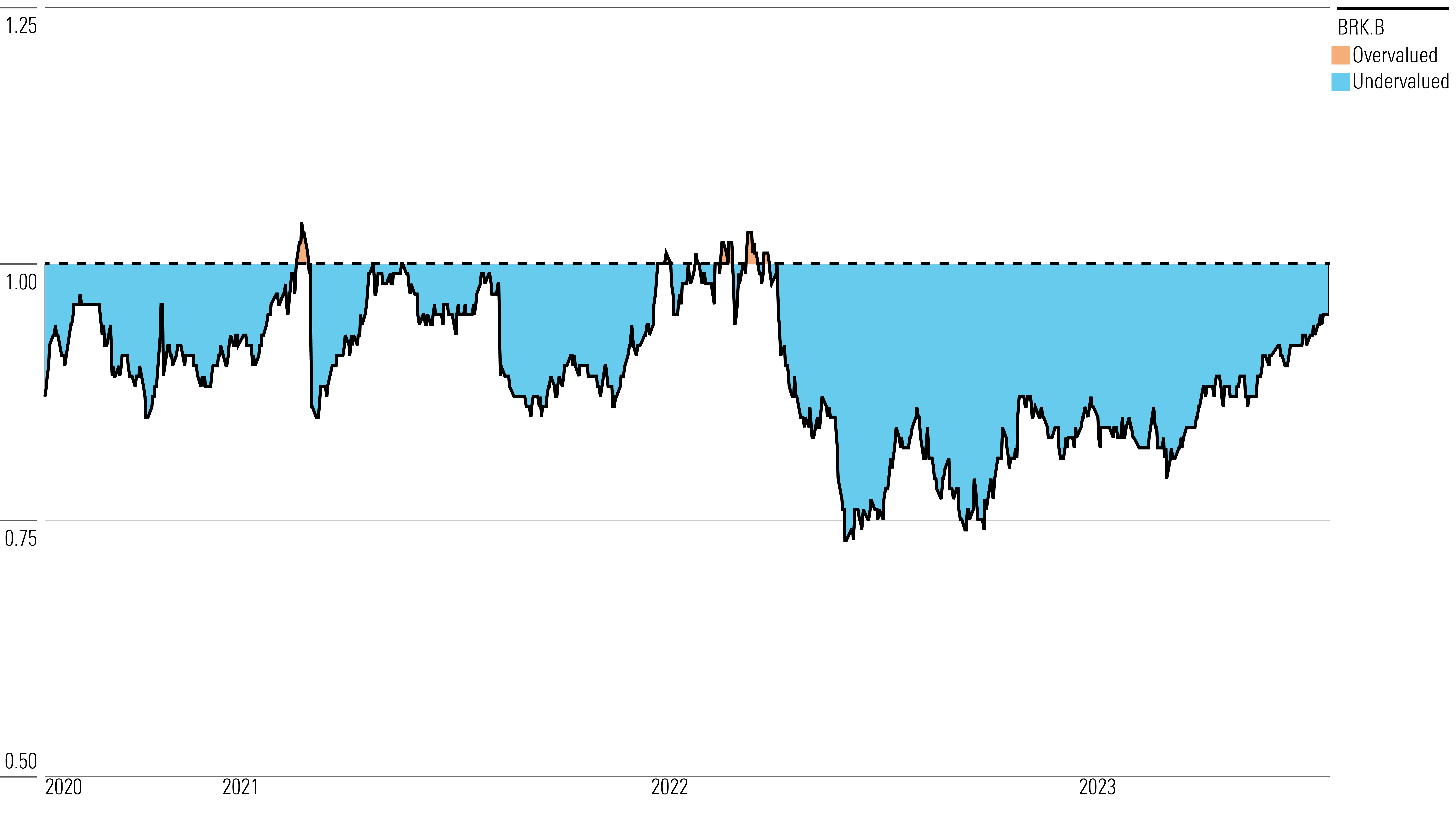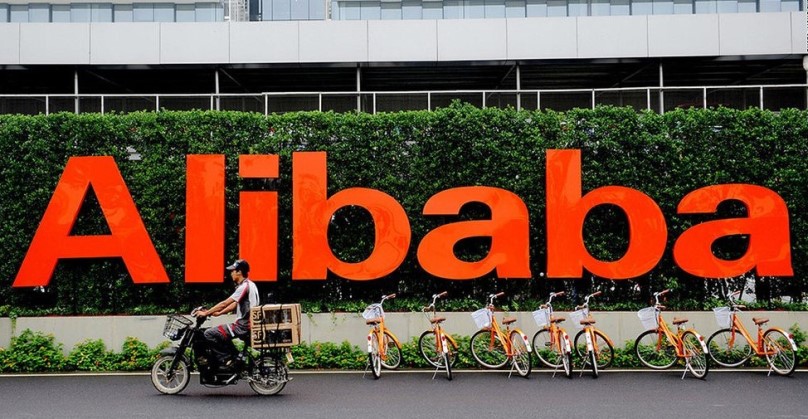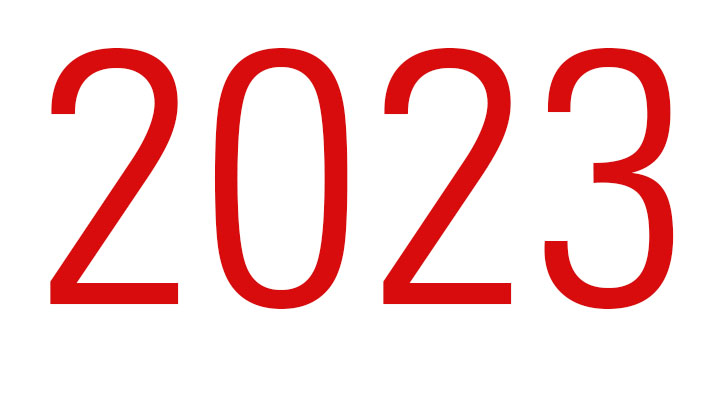:quality(80)/cloudfront-us-east-1.images.arcpublishing.com/morningstar/FGC25JIKZ5EATCXF265D56SZTE.jpg)
Berkshire Hathaway BRK.B released its second-quarter earnings report on Aug. 6. Here’s Morningstar’s take on Berkshire Hathaway’s earnings and stock.
Key Morningstar Metrics for Berkshire Hathaway Class B
- Fair Value Estimate: US$370
- Morningstar Rating: 4 stars
- Morningstar Economic Moat Rating: Wide
- Morningstar Uncertainty Rating: Low
What We Thought of Berkshire Hathaway’s Q2 Earnings
Earnings Summary: We expected stronger underwriting results from Berkshire’s insurance operations, given the contributions from the Alleghany deal, price hardening in the P&C and reinsurance businesses, and continued price increases in Geico’s personal auto insurance operations, as well as the inclusion of Pilot Travel Centers into overall results. But this was offset some by declining volumes and profitability at BNSF, as well as weaker results from some parts of BHE (given the sharp drop in business for its residential real estate and brokerage operations) and the MSR division (as revenue from consumer products and building products fell off double digits). That said, these results fully demonstrate the benefits of Berkshire’s decentralized business model, broad business diversification, high cash-generation capabilities, and unmatched balance sheet strength.
Overall Earnings: Operating earnings per share increased 8.2% year over year to $6,928 ($4.62) per class A (B) share on $92.5 billion of operating revenue (which excludes the impact of investment gains/losses and other adjustments). This easily surpassed the FactSet consensus estimate of $5,576 ($3.72) per Class A (B) share but was close enough to our own estimate(s) to keep our fair value estimate of $555,000 ($370) per Class A (B) share.
Insurance Businesses: Berkshire’s second-quarter operating earnings benefited from higher insurance underwriting profits, which rose to $1.2 billion from $715 million in the same period during the prior year. The company’s Geico personal auto insurance business put up far better results year over year, recording an underwriting profit of $514 million in the second quarter of 2023 compared with a loss of $487 million in the year-ago period, as price increases and more disciplined underwriting allowed the unit to post its second straight quarter of positive underwriting results. As for BHRG and BHPG, catastrophe losses weighed on results during the second quarter, but both units benefited from price hardening in the P&C and reinsurance businesses, as well as including acquired Alleghany operations in their own operations. Meanwhile, overall insurance investment income increased to $2.9 billion in the second quarter from $2.3 billion in the year-ago period, reflecting the impact of higher short-term rates and large cash and cash equivalents balance (most of which is in U.S. Treasury Bills).
Railroads: Berkshire’s BNSF railroad operations experienced a 24% decline in second-quarter operating earnings to $1.3 billion after taxes, reflecting lower freight volumes (down 11%), flattish average revenue per car/unit, and higher non-fuel operating expenses (up 9%). Relative to the same period(s) last year, intermodal demand is facing retailer inventory destocking and loose capacity in the competing truckload sector, industrial end markets have turned sluggish, and coal fell due to rising competition from natural gas. On top of that, the industry saw declining fuel surcharges year over year. BNSF fell short of its closest peer, Union Pacific, even as that firm faced lower freight volumes (down 2%), lower average revenue per car/unit (down 3%), and higher non-fuel operating expenses (up 9%). BNSF’s operating ratio declined to 69.2% in the June quarter from 64.2% in the year-ago period, compared with Union Pacific’s operating ratio of 63.0% for the June quarter (which was a decline from 60.2% in the year-ago period).
Utilities/Earnings Division: Despite a meaningful drop in residential real estate and brokerage earnings for BHE, owing to the rapid rise in rates over the past year, earnings at Berkshire’s utility/energy division were relatively unchanged at $785 million in the second quarter relative to $789 million in the year-ago period (owing in a large part to higher levels of other income and significant production tax credits from wind-powered electricity generation). We continue to believe that ongoing constructive rate case outcomes will lead to EBITDA growth in a 5%-6% range on average annually over the next five years for Berkshire’s regulated U.S. utilities, even as the company ramps up growth and operating capital expenditures. We believe the more recent drop in earnings from the residential real estate and brokerage business will eventually recover from its recent lows as rates decline some over the next several years.
Other Business Lines: Regarding Berkshire’s manufacturing, service, and retail operations, the firm not only benefited from the addition of several businesses from the Alleghany acquisition but also kept its pre-tax operating margins elevated at 10.7%, despite weakness in the consumer products (revenue down 18.7% year over year during the June quarter) and building products (down 13.2%) segments. We should also note that with the MSR division housing some of Berkshire’s more economically sensitive segments (such as industrial and end-user products, rail products and services, building products, consumer products, consumer and commercial services, retail, and restaurant supply), it will be unable to escape a downdraft should we see a more dramatic slowdown in economic activity.
Investment Results: Overall results (which include the impact of investment gains/losses and other adjustments) benefited from Berkshire’s equity investment portfolio rising in value to $353.4 billion during the second quarter despite the company being a net seller of stocks (with the firm recording sales of $12.6 billion and stock purchases of $4.6 billion during the period). Berkshire benefited from its large position in Apple (which by our estimates accounted for 47.6% of Berkshire’s equity holdings at the end of June 2023), with shares of the tech giant’s common stock rising 18% during the second quarter, 50% during the first half of 2023, and 43% year over year at the end of June 2023. Berkshire was also a net seller of stocks during the first quarter (with the firm recording sales of $13.3 billion and stock purchases of $2.9 billion during the period).
Cash Holdings: Berkshire closed out the second quarter with $147.4 billion in cash and cash equivalents, up from $130.6 billion at the end of March 2023, as unutilized free cash flow, along with net stock sales of $8.0 billion, kept the firm from reducing cash balances. By our estimates, Berkshire came into the third quarter with $106.9 billion in dry powder. We arrive at that figure by taking the firm’s $147.7 billion in cash and equivalents and subtracting the $35 billion that we think the company needs to keep on hand as a backstop for the insurance business, and then excluding the operating cash needs for Berkshire’s subsidiaries (which by our estimates was $1.9 billion, or 2% of the $106.7 billion in operating revenue that the firm generated during the June quarter), as well as the funding needs for next quarter’s anticipated capital spending (which we estimate to be $3.9 billion).
Stock Repurchases: Berkshire’s stock repurchases totaled $1.4 billion during the second quarter, compared with $4.4 billion in the first quarter of 2023 and $1.0 billion in the year-ago period. The company appeared to be willing to buy back stock at 1.42 times the prior quarter’s book value per share and 1.34 times the pending quarter’s book value per share—slightly above the price points at which Berkshire was buying back more than $6.2 billion a quarter on average during 2020-21. With CEO Warren Buffett and Vice Chairman Charlie Munger being more price-sensitive when buying back Berkshire’s own shares, we expect that the run-up in the shares over the past year or so has lowered their appetite. We recently removed Berkshire from our Best Ideas list, as the valuation on the shares was no longer providing a wide enough margin of safety to warrant a recommendation.
Berkshire Stock Performance: We added Berkshire to the Best Ideas list at the end of June 2022. The firm has typically offered one of the better risk-adjusted return profiles in the financial services sector. It is generally seen as a solid candidate for downside protection during market selloffs, exemplified by its outperforming U.S. equity benchmarks last year. In June 2022, the firm’s stock was trading at a meaningful discount to our fair value estimate. Since then, the shares have rallied along with the rising U.S. equity markets, and we now believe its stock is fairly valued relative to our fair value estimate of $555,000 ($370) per Class A (B) share.
Berkshire Hathaway Stock Price Chart
Fair Value Estimate for Berkshire Hathaway Class B
With its 4-star rating, we believe Berkshire Hathaway’s stock is undervalued compared with our long-term fair value estimate.
Our fair value estimate for Berkshire Hathaway is $370 per Class B share, which is equivalent to 1.45 and 1.33 times our estimates for Berkshire’s book value per share at the ends of 2023 and 2024, respectively. Our fair value estimate is derived using a sum-of-the-parts methodology, valuing each of Berkshire’s operating segments separately and then adding them back together.
After updating our valuation model for 2022 results, as well as revising our projections for 2023-27, we have increased our valuation for Berkshire’s insurance operations to $172 per Class B share from $166, owing to adjustments we’ve made to its earned premium growth, underwriting profitability, and returns and overall yield on its investment portfolio.
Our valuation of Berkshire’s railroad operations decreased to $56 per Class B share from $58, with our revised forecast assuming that carload volumes increase at a 1.1% compound annual growth rate in 2023-27 (compared with negative 1.5% previously), with freight revenue expanding 3.5% on average annually and BNSF’s operating ratio reaching 63.8% at the end of 2027 (down from 66.8% at the end of 2022).
Berkshire Hathaway Historical Price/Fair Value Ratios
Ratios over 1.00 indicate when the stock is overvalued, while ratios below 1.00 mean the stock is undervalued.

Source: Morningstar Direct. Data as of August 4, 2023.
Read more about Berkshire Hathaway’s fair value estimate.
Economic Moat Rating
We’ve historically believed that Berkshire’s economic moat is more than just the sum of its parts, although the parts are fairly moaty. The insurance operations—Geico, Berkshire Hathaway Reinsurance Group, and Berkshire Hathaway Primary Group—remain important contributors to the overall business. Not only do they account for around 25% of Berkshire’s pretax earnings (and 46% of our current valuation of the firm), but they are also overcapitalized (maintaining a larger-than-normal equity investment portfolio for a property and casualty insurer) and generate low-cost float.
These temporary cash holdings, which arise from premiums being collected in advance of future claims, have allowed Berkshire to generate additional returns as the company invests these funds in assets that are commensurate with the duration of the business being underwritten. And they have tended to come at little to no cost to Berkshire, given the company’s proclivity for generating underwriting gains over the past several decades.
That said, we don’t believe the insurance industry is particularly conducive to developing maintainable competitive advantages. While there are some high-quality firms in the industry (with Berkshire having some of the best operators in the segments where it competes), the product insurers sell is basically a commodity, with excess returns difficult to achieve on a consistent basis. Buyers of insurance are not inclined to pay a premium for brands, and the products themselves are easily replicable. Competition among insurance firms is fierce, and participants have been known to slash prices or undercut competitors to gain market share.
Read more about Berkshire Hathaway’s moat rating.
Risk and Uncertainty
Our Morningstar Uncertainty Rating for Berkshire Hathaway is Low. Berkshire faces the risk that insurance claims exceed loss reserves or that material impairments affect its investment portfolio. Several of the firm’s key businesses—insurance, energy generation and distribution, and rail transport—operate in industries that are subject to higher degrees of regulatory oversight, which could affect future business combinations, as well as the setting of rates charged to customers. Many of the company’s noninsurance operations are exposed to the cyclicality of the economy, with results suffering during economic slowdowns.
Berkshire depends on two key employees—Warren Buffett and Charlie Munger—for almost all its investment and capital allocation decisions. With Buffett turning 93 in August and Munger having turned 99 in January, it is increasingly likely that our valuation horizon will exceed their lifespans, with the quality of investment returns and capital allocation likely being affected.
Read more about Berkshire Hathaway’s risk and uncertainty.
BRK.B Bulls Say
- Book value per share, which is a good proxy for measuring changes in Berkshire’s intrinsic value, increased at an estimated 18.3% CAGR during 1965-2022, compared with a 9.9% annualized return for the S&P 500 TR Index.
- Berkshire’s stock performance has generally been solid, increasing at a 9.5% (13.3%) CAGR during 2018-22 (2013-22), compared with a 9.4% (12.6%) average annual return for the S&P 500 TR Index.
- At the end of 2022, Berkshire had approximately $164 billion in insurance float. The cost of its float has been negative for much of the past two decades.
BRK.B Bears Say
- Given its size, Berkshire’s biggest long-term hurdle will be its ability to consistently find deals that not only add value but are also large enough to be meaningful.
- Another big issue facing the firm is the longevity of chair and CEO Warren Buffett (who turns 93 at the end of August 2023) and managing partner Charlie Munger (who turned 99 in January 2023).
- Berkshire’s insurance business faces competitive and highly cyclical markets that occasionally produce large losses, and several of its noninsurance operations are economically sensitive and focused on U.S. markets.






:quality(80)/cloudfront-us-east-1.images.arcpublishing.com/morningstar/PDHJPZBNVRCAFEQ2AHYHABU2AU.png)

:quality(80)/cloudfront-us-east-1.images.arcpublishing.com/morningstar/IW43ZPMYP5EOPCVKLFZ3IUVTZU.png)




.png)









